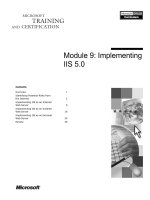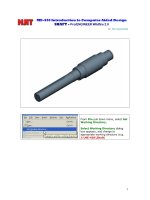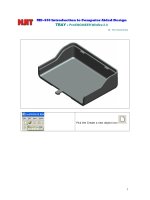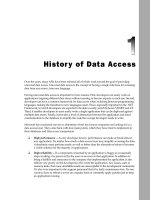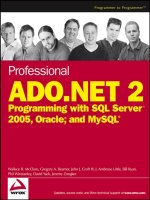Tài liệu Professional ASP.NET MVC 1.0 docx
Bạn đang xem bản rút gọn của tài liệu. Xem và tải ngay bản đầy đủ của tài liệu tại đây (13.83 MB, 196 trang )
Professional ASP.NET MVC 1.0
Published by
Wiley Publishing, Inc.
10475 Crosspoint Boulevard
Indianapolis, IN 46256
www.wiley.com.
Copyright © 2009 by Wiley Publishing, Inc., Indianapolis, Indiana
Chapter 1 is licensed under the terms of the Creative Commons Attribution No Derivatives 3.0 license.
Published simultaneously in Canada
ISBN: 978-0-470-38461-9
Manufactured in the United States of America
10 9 8 7 6 5 4 3 2 1
Library of Congress Cataloging-in-Publication Data is available from the publisher.
No part of this publication may be reproduced, stored in a retrieval system or transmitted in any form
or by any means, electronic, mechanical, photocopying, recording, scanning or otherwise, except as
permitted under Sections 107 or 108 of the 1976 United States Copyright Act, without either the prior
written permission of the Publisher, or authorization through payment of the appropriate per-copy
fee to the Copyright Clearance Center, 222 Rosewood Drive, Danvers, MA 01923, (978) 750-8400, fax
(978) 646-8600. Requests to the Publisher for permission should be addressed to the Permissions
Department, John Wiley & Sons, Inc., 111 River Street, Hoboken, NJ 07030, (201) 748-6011, fax
(201) 748-6008, or online at
/>Limit of Liability/Disclaimer of Warranty: The publisher and the author make no representations or war-
ranties with respect to the accuracy or completeness of the contents of this work and specifically disclaim
all warranties, including without limitation warranties of fitness for a particular purpose. No warranty
may be created or extended by sales or promotional materials. The advice and strategies contained herein
may not be suitable for every situation. This work is sold with the understanding that the publisher is not
engaged in rendering legal, accounting, or other professional services. If professional assistance is required,
the services of a competent professional person should be sought. Neither the publisher nor the author
shall be liable for damages arising herefrom. The fact that an organization or Website is referred to in this
work as a citation and/or a potential source of further information does not mean that the author or the
publisher endorses the information the organization or Website may provide or recommendations it may
make. Further, readers should be aware that Internet Websites listed in this work may have changed or dis-
appeared between when this work was written and when it is read.
For general information on our other products and services please contact our Customer Care Department
within the United States at (877) 762-2974, outside the United States at (317) 572-3993 or fax (317) 572-4002.
Trademarks: Wiley, the Wiley logo, Wrox, the Wrox logo, Wrox Programmer to Programmer, and related
trade dress are trademarks or registered trademarks of John Wiley & Sons, Inc. and/or its affiliates, in the
United States and other countries, and may not be used without written permission. All other trademarks
are the property of their respective owners. Wiley Publishing, Inc., is not associated with any product or
vendor mentioned in this book.
Wiley also publishes its books in a variety of electronic formats. Some content that appears in print may not
be available in electronic books.
84619ffirsw.indd 6 3/3/09 8:30:50 AM
Professional ASP.NET MVC 1.0
Table of Contents
Chapter 1: NerdDinner.
Chapter 2: Model View Controller and ASP.NET.
Chapter 3: ASP.NET > ASP.NET MVC.
Chapter 4: Routes and URLs.
Chapter 5: Controllers.
Chapter 6: Views.
Chapter 7: AJAX.
Chapter 8: Filters.
Chapter 9: Securing Your Application.
Chapter 10: Test Driven Development With ASP.NET MVC.
Chapter 11: Testable Design Patterns.
Chapter 12: Best of Both Worlds: Web Forms and MVC Together.
Page 2 of 186
Chapter 1 is licensed under the terms of Creative Commons Attribution No Derivatives 3.0 license and may be redistributed according to those terms with the
following attribution: “Chapter 1 “NerdDinner” from Professional ASP.NET MVC 1.0 written by Rob Conery et al published by Wrox (ISBN: 978-0-470-38461-9) may
be redistributed under the terms of Creative Commons Attribution No Derivatives 3.0 license. The original copy is available at The
complete book Professional ASP.NET MVC 1.0 is copyright 2009 by Wiley Publishing Inc and may not be redistributed without permission.”
Chapter Contents
NerdDinner 3
File->New Project 8
Creating the Database 17
Building the Model 26
Controllers and Views 42
Create, Update, Delete Form Scenarios 67
ViewData and ViewModel 101
Partials and Master Pages 108
Paging Support 118
Authentication and Authorization 127
AJAX Enabling RSVPs Accepts 138
Integrating an AJAX Map 146
Unit Testing 165
NerdDinner Wrap Up 186
Page 3 of 186
Chapter 1 is licensed under the terms of Creative Commons Attribution No Derivatives 3.0 license and may be redistributed according to those terms with the
following attribution: “Chapter 1 “NerdDinner” from Professional ASP.NET MVC 1.0 written by Rob Conery et al published by Wrox (ISBN: 978-0-470-38461-9) may
be redistributed under the terms of Creative Commons Attribution No Derivatives 3.0 license. The original copy is available at The
complete book Professional ASP.NET MVC 1.0 is copyright 2009 by Wiley Publishing Inc and may not be redistributed without permission.”
NerdDinner
The best way to learn a new framework is to build something with it. This first chapter walks through
how to build a small, but complete, application using ASP.NET MVC, and introduces some of the core
concepts behind it.
The application we are going to build is called “NerdDinner”. NerdDinner provides an easy way for
people to find and organize dinners online:
NerdDinner enables registered users to create, edit and delete dinners. It enforces a consistent set of
validation and business rules across the application:
Page 4 of 186
Chapter 1 is licensed under the terms of Creative Commons Attribution No Derivatives 3.0 license and may be redistributed according to those terms with the
following attribution: “Chapter 1 “NerdDinner” from Professional ASP.NET MVC 1.0 written by Rob Conery et al published by Wrox (ISBN: 978-0-470-38461-9) may
be redistributed under the terms of Creative Commons Attribution No Derivatives 3.0 license. The original copy is available at The
complete book Professional ASP.NET MVC 1.0 is copyright 2009 by Wiley Publishing Inc and may not be redistributed without permission.”
Visitors to the site can search to find upcoming dinners being held near them:
Page 5 of 186
Chapter 1 is licensed under the terms of Creative Commons Attribution No Derivatives 3.0 license and may be redistributed according to those terms with the
following attribution: “Chapter 1 “NerdDinner” from Professional ASP.NET MVC 1.0 written by Rob Conery et al published by Wrox (ISBN: 978-0-470-38461-9) may
be redistributed under the terms of Creative Commons Attribution No Derivatives 3.0 license. The original copy is available at The
complete book Professional ASP.NET MVC 1.0 is copyright 2009 by Wiley Publishing Inc and may not be redistributed without permission.”
Clicking a dinner will take them to a details page where they can learn more about it:
If they are interested in attending the dinner they can login or register on the site:
Page 6 of 186
Chapter 1 is licensed under the terms of Creative Commons Attribution No Derivatives 3.0 license and may be redistributed according to those terms with the
following attribution: “Chapter 1 “NerdDinner” from Professional ASP.NET MVC 1.0 written by Rob Conery et al published by Wrox (ISBN: 978-0-470-38461-9) may
be redistributed under the terms of Creative Commons Attribution No Derivatives 3.0 license. The original copy is available at The
complete book Professional ASP.NET MVC 1.0 is copyright 2009 by Wiley Publishing Inc and may not be redistributed without permission.”
They can then easily RSVP to attend the event:
Page 7 of 186
Chapter 1 is licensed under the terms of Creative Commons Attribution No Derivatives 3.0 license and may be redistributed according to those terms with the
following attribution: “Chapter 1 “NerdDinner” from Professional ASP.NET MVC 1.0 written by Rob Conery et al published by Wrox (ISBN: 978-0-470-38461-9) may
be redistributed under the terms of Creative Commons Attribution No Derivatives 3.0 license. The original copy is available at The
complete book Professional ASP.NET MVC 1.0 is copyright 2009 by Wiley Publishing Inc and may not be redistributed without permission.”
We are going to begin implementing the NerdDinner application by using the File->New Project
command within Visual Studio to create a brand new ASP.NET MVC project. We’ll then incrementally
add functionality and features. Along the way we’ll cover how to create a database, build a model with
business rule validations, implement data listing/details UI, provide CRUD (Create, Update, Delete) form
entry support, implement efficient data paging, reuse UI using master pages and partials, secure the
application using authentication and authorization, use AJAX to deliver dynamic updates and interactive
map support, and implement automated unit testing.
You can build your own copy of NerdDinner from scratch by completing each step we walkthrough in
this chapter. Alternatively, you can download a completed version of the source code here:
You can use either Visual Studio 2008 or the free Visual Web Developer 2008 Express to build the
application. You can use either SQL Server or the free SQL Server Express to host the database.
You can install ASP.NET MVC, Visual Web Developer 2008, and SQL Server Express using the Microsoft
Web Platform Installer available here:
Page 8 of 186
Chapter 1 is licensed under the terms of Creative Commons Attribution No Derivatives 3.0 license and may be redistributed according to those terms with the
following attribution: “Chapter 1 “NerdDinner” from Professional ASP.NET MVC 1.0 written by Rob Conery et al published by Wrox (ISBN: 978-0-470-38461-9) may
be redistributed under the terms of Creative Commons Attribution No Derivatives 3.0 license. The original copy is available at The
complete book Professional ASP.NET MVC 1.0 is copyright 2009 by Wiley Publishing Inc and may not be redistributed without permission.”
File->New Project
We’ll begin our NerdDinner application by selecting the File->New Project menu item within Visual
Studio 2008 or the free Visual Web Developer 2008 Express.
This will bring up the “New Project” dialog. To create a new ASP.NET MVC application, we’ll select the
“Web” node on the left-hand side of the dialog and then choose the “ASP.NET MVC Web Application”
project template on the right:
We’ll name the new project “NerdDinner” and then click the “ok” button to create it.
When we click "ok" Visual Studio will bring up an additional dialog that prompts us to optionally create a
unit test project for the new application as well. This unit test project enables us to create automated
tests that verify the functionality and behavior of our application (something we’ll cover how to-do later
in this tutorial).
Page 9 of 186
Chapter 1 is licensed under the terms of Creative Commons Attribution No Derivatives 3.0 license and may be redistributed according to those terms with the
following attribution: “Chapter 1 “NerdDinner” from Professional ASP.NET MVC 1.0 written by Rob Conery et al published by Wrox (ISBN: 978-0-470-38461-9) may
be redistributed under the terms of Creative Commons Attribution No Derivatives 3.0 license. The original copy is available at The
complete book Professional ASP.NET MVC 1.0 is copyright 2009 by Wiley Publishing Inc and may not be redistributed without permission.”
The "Test framework" dropdown in the above dialog is populated with all available ASP.NET MVC unit
test project templates installed on the machine. Versions can be downloaded for NUnit, MBUnit, and
XUnit. The built-in Visual Studio Unit Test framework is also supported.
Note: The Visual Studio Unit Test Framework is only available with Visual Studio 2008 Professional and
higher versions). If you are using VS 2008 Standard Edition or Visual Web Developer 2008 Express you
will need to download and install the NUnit, MBUnit or XUnit extensions for ASP.NET MVC in order for
this dialog to be shown. The dialog will not display if there aren’t any test frameworks installed.
We'll use the default "NerdDinner.Tests" name for the test project we create, and use the “Visual Studio
Unit Test” framework option. When we click the "ok" button Visual Studio will create a solution for us
with two projects in it - one for our web application and one for our unit tests:
Page 10 of 186
Chapter 1 is licensed under the terms of Creative Commons Attribution No Derivatives 3.0 license and may be redistributed according to those terms with the
following attribution: “Chapter 1 “NerdDinner” from Professional ASP.NET MVC 1.0 written by Rob Conery et al published by Wrox (ISBN: 978-0-470-38461-9) may
be redistributed under the terms of Creative Commons Attribution No Derivatives 3.0 license. The original copy is available at The
complete book Professional ASP.NET MVC 1.0 is copyright 2009 by Wiley Publishing Inc and may not be redistributed without permission.”
Examining the NerdDinner directory structure
When you create a new ASP.NET MVC application with Visual Studio, it automatically adds a number of
files and directories to the project:
ASP.NET MVC projects by default have six top-level directories:
Directory
Purpose
/Controllers Where you put Controller classes that handle URL requests
/Models
Where you put classes that represent and manipulate data
/Views Where you put UI template files that are responsible for rendering output
/Scripts
Where you put JavaScript library files and scripts (.js)
/Content Where you put CSS and image files, and other non-dynamic/non-JavaScript content
/App_Data Where you store data files you want to read/write.
ASP.NET MVC does not require this structure. In fact, developers working on large applications will
typically partition the application up across multiple projects to make it more manageable (for example:
data model classes often go in a separate class library project from the web application). The default
project structure, however, does provide a nice default directory convention that we can use to keep
our application concerns clean.
When we expand the /Controllers directory we’ll find that Visual Studio added two controller classes –
HomeController and AccountController – by default to the project:
Page 11 of 186
Chapter 1 is licensed under the terms of Creative Commons Attribution No Derivatives 3.0 license and may be redistributed according to those terms with the
following attribution: “Chapter 1 “NerdDinner” from Professional ASP.NET MVC 1.0 written by Rob Conery et al published by Wrox (ISBN: 978-0-470-38461-9) may
be redistributed under the terms of Creative Commons Attribution No Derivatives 3.0 license. The original copy is available at The
complete book Professional ASP.NET MVC 1.0 is copyright 2009 by Wiley Publishing Inc and may not be redistributed without permission.”
When we expand the /Views directory, we’ll find three sub-directories – /Home, /Account and /Shared –
as well as several template files within them were also added to the project by default:
Page 12 of 186
Chapter 1 is licensed under the terms of Creative Commons Attribution No Derivatives 3.0 license and may be redistributed according to those terms with the
following attribution: “Chapter 1 “NerdDinner” from Professional ASP.NET MVC 1.0 written by Rob Conery et al published by Wrox (ISBN: 978-0-470-38461-9) may
be redistributed under the terms of Creative Commons Attribution No Derivatives 3.0 license. The original copy is available at The
complete book Professional ASP.NET MVC 1.0 is copyright 2009 by Wiley Publishing Inc and may not be redistributed without permission.”
When we expand the /Content and /Scripts directories, we’ll find a Site.css file that is used to style all
HTML on the site, as well as JavaScript libraries that can enable ASP.NET AJAX and jQuery support within
the application:
When we expand the NerdDinner.Tests project we’ll find two classes that contain unit tests for our
controller classes:
Page 13 of 186
Chapter 1 is licensed under the terms of Creative Commons Attribution No Derivatives 3.0 license and may be redistributed according to those terms with the
following attribution: “Chapter 1 “NerdDinner” from Professional ASP.NET MVC 1.0 written by Rob Conery et al published by Wrox (ISBN: 978-0-470-38461-9) may
be redistributed under the terms of Creative Commons Attribution No Derivatives 3.0 license. The original copy is available at The
complete book Professional ASP.NET MVC 1.0 is copyright 2009 by Wiley Publishing Inc and may not be redistributed without permission.”
These default files added by Visual Studio provide us with a basic structure for a working application -
complete with home page, about page, account login/logout/registration pages, and an unhandled error
page (all wired-up and working out of the box).
Running the NerdDinner Application
We can run the project by choosing either the Debug->Start Debugging or Debug->Start Without
Debugging menu items:
This will launch the built-in ASP.NET Web-server that comes with Visual Studio, and run our application:
Page 14 of 186
Chapter 1 is licensed under the terms of Creative Commons Attribution No Derivatives 3.0 license and may be redistributed according to those terms with the
following attribution: “Chapter 1 “NerdDinner” from Professional ASP.NET MVC 1.0 written by Rob Conery et al published by Wrox (ISBN: 978-0-470-38461-9) may
be redistributed under the terms of Creative Commons Attribution No Derivatives 3.0 license. The original copy is available at The
complete book Professional ASP.NET MVC 1.0 is copyright 2009 by Wiley Publishing Inc and may not be redistributed without permission.”
Below is the home page for our new project (URL: “/”) when it runs:
Clicking the “About” tab displays an about page (URL: “/Home/About”):
Page 15 of 186
Chapter 1 is licensed under the terms of Creative Commons Attribution No Derivatives 3.0 license and may be redistributed according to those terms with the
following attribution: “Chapter 1 “NerdDinner” from Professional ASP.NET MVC 1.0 written by Rob Conery et al published by Wrox (ISBN: 978-0-470-38461-9) may
be redistributed under the terms of Creative Commons Attribution No Derivatives 3.0 license. The original copy is available at The
complete book Professional ASP.NET MVC 1.0 is copyright 2009 by Wiley Publishing Inc and may not be redistributed without permission.”
Clicking the “Log On” link on the top-right takes us to a Login page (URL: “/Account/LogOn”)
If we don’t have a login account we can click the register link (URL: “/Account/Register”) to create one:
Page 16 of 186
Chapter 1 is licensed under the terms of Creative Commons Attribution No Derivatives 3.0 license and may be redistributed according to those terms with the
following attribution: “Chapter 1 “NerdDinner” from Professional ASP.NET MVC 1.0 written by Rob Conery et al published by Wrox (ISBN: 978-0-470-38461-9) may
be redistributed under the terms of Creative Commons Attribution No Derivatives 3.0 license. The original copy is available at The
complete book Professional ASP.NET MVC 1.0 is copyright 2009 by Wiley Publishing Inc and may not be redistributed without permission.”
The code to implement the above home, about, and logout/ register functionality was added by default
when we created our new project. We’ll use it as the starting point of our application.
Testing the NerdDinner Application
If we are using the Professional Edition or higher version of Visual Studio 2008, we can use the built-in
unit testing IDE support within Visual Studio to test the project:
Choosing one of the above options will open the “Test Results” pane within the IDE and provide us with
pass/fail status on the 27 unit tests included in our new project that cover the built-in functionality:
Page 17 of 186
Chapter 1 is licensed under the terms of Creative Commons Attribution No Derivatives 3.0 license and may be redistributed according to those terms with the
following attribution: “Chapter 1 “NerdDinner” from Professional ASP.NET MVC 1.0 written by Rob Conery et al published by Wrox (ISBN: 978-0-470-38461-9) may
be redistributed under the terms of Creative Commons Attribution No Derivatives 3.0 license. The original copy is available at The
complete book Professional ASP.NET MVC 1.0 is copyright 2009 by Wiley Publishing Inc and may not be redistributed without permission.”
Creating the Database
We’ll be using a database to store all of the Dinner and RSVP data for our NerdDinner application.
The steps below show creating the database using the free SQL Server Express edition. All of the code
we’ll write works with both SQL Server Express and the full SQL Server.
Creating a new SQL Server Express database
We’ll begin by right-clicking on our web project, and then select the Add->New Item menu command:
This will bring up the “Add New Item” dialog. We’ll filter by the “Data” category and select the “SQL
Server Database” item template:
Page 18 of 186
Chapter 1 is licensed under the terms of Creative Commons Attribution No Derivatives 3.0 license and may be redistributed according to those terms with the
following attribution: “Chapter 1 “NerdDinner” from Professional ASP.NET MVC 1.0 written by Rob Conery et al published by Wrox (ISBN: 978-0-470-38461-9) may
be redistributed under the terms of Creative Commons Attribution No Derivatives 3.0 license. The original copy is available at The
complete book Professional ASP.NET MVC 1.0 is copyright 2009 by Wiley Publishing Inc and may not be redistributed without permission.”
We’ll name the SQL Server Express database we want to create “NerdDinner.mdf” and hit ok. Visual
Studio will then ask us if we want to add this file to our \App_Data directory (which is a directory already
setup with both read and write security ACLs):
We’ll click “Yes” and our new database will be created and added to our Solution Explorer:
Page 19 of 186
Chapter 1 is licensed under the terms of Creative Commons Attribution No Derivatives 3.0 license and may be redistributed according to those terms with the
following attribution: “Chapter 1 “NerdDinner” from Professional ASP.NET MVC 1.0 written by Rob Conery et al published by Wrox (ISBN: 978-0-470-38461-9) may
be redistributed under the terms of Creative Commons Attribution No Derivatives 3.0 license. The original copy is available at The
complete book Professional ASP.NET MVC 1.0 is copyright 2009 by Wiley Publishing Inc and may not be redistributed without permission.”
Creating Tables within our Database
We now have a new empty database. Let’s add some tables to it.
To do this we’ll navigate to the “Server Explorer” tab window within Visual Studio, which enables us to
manage databases and servers. SQL Server Express databases stored in the \App_Data folder of our
application will automatically show up within the Server Explorer. We can optionally use the “Connect
to Database” icon on the top of the “Server Explorer” window to add additional SQL Server databases
(both local and remote) to the list as well:
Page 20 of 186
Chapter 1 is licensed under the terms of Creative Commons Attribution No Derivatives 3.0 license and may be redistributed according to those terms with the
following attribution: “Chapter 1 “NerdDinner” from Professional ASP.NET MVC 1.0 written by Rob Conery et al published by Wrox (ISBN: 978-0-470-38461-9) may
be redistributed under the terms of Creative Commons Attribution No Derivatives 3.0 license. The original copy is available at The
complete book Professional ASP.NET MVC 1.0 is copyright 2009 by Wiley Publishing Inc and may not be redistributed without permission.”
We will add two tables to our NerdDinner database – one to store our Dinners, and the other to track
RSVP acceptances to them. We can create new tables by right-clicking on the “Tables” folder within our
database and choosing the “Add New Table” menu command:
This will open up a table designer that allows us to configure the schema of our table. For our “Dinners”
table we will add 10 columns of data:
Page 21 of 186
Chapter 1 is licensed under the terms of Creative Commons Attribution No Derivatives 3.0 license and may be redistributed according to those terms with the
following attribution: “Chapter 1 “NerdDinner” from Professional ASP.NET MVC 1.0 written by Rob Conery et al published by Wrox (ISBN: 978-0-470-38461-9) may
be redistributed under the terms of Creative Commons Attribution No Derivatives 3.0 license. The original copy is available at The
complete book Professional ASP.NET MVC 1.0 is copyright 2009 by Wiley Publishing Inc and may not be redistributed without permission.”
We want the “DinnerID” column to be a unique primary key for the table. We can configure this by
right-clicking on the “DinnerID” column and choosing the “Set Primary Key” menu item:
In addition to making DinnerID a primary key, we also want configure it as an “identity” column whose
value is automatically incremented as new rows of data are added to the table (meaning the first
inserted Dinner row will have a DinnerID of 1, the second inserted row will have a DinnerID of 2, etc).
We can do this by selecting the “DinnerID” column and then use the “Column Properties” editor to set
the “(Is Identity)” property on the column to “Yes”. We will use the standard identity defaults (start at 1
and increment 1 on each new Dinner row):
Page 22 of 186
Chapter 1 is licensed under the terms of Creative Commons Attribution No Derivatives 3.0 license and may be redistributed according to those terms with the
following attribution: “Chapter 1 “NerdDinner” from Professional ASP.NET MVC 1.0 written by Rob Conery et al published by Wrox (ISBN: 978-0-470-38461-9) may
be redistributed under the terms of Creative Commons Attribution No Derivatives 3.0 license. The original copy is available at The
complete book Professional ASP.NET MVC 1.0 is copyright 2009 by Wiley Publishing Inc and may not be redistributed without permission.”
We’ll then save our table by typing Ctrl-S or by using the File->Save menu command. This will prompt us
to name the table. We’ll name it “Dinners”:
Our new Dinners table will then show up within our database in the server explorer.
We’ll then repeat the above steps and create a “RSVP” table. This table with have 3 columns. We will
setup the RsvpID column as the primary key, and also make it an identity column:
We’ll save it and give it the name “RSVP”.
Setting up a Foreign Key Relationship between Tables
We now have two tables within our database. Our last schema design step will be to setup a “one-to-
many” relationship between these two tables – so that we can associate each Dinner row with zero or
more RSVP rows that apply to it. We will do this by configuring the RSVP table’s “DinnerID” column to
have a foreign-key relationship to the “DinnerID” column in the “Dinners” table.
To do this we’ll open up the RSVP table within the table designer by double-clicking it in the server
explorer. We’ll then select the “DinnerID” column within it, right-click, and choose the “Relationshps…”
context menu command:
Page 23 of 186
Chapter 1 is licensed under the terms of Creative Commons Attribution No Derivatives 3.0 license and may be redistributed according to those terms with the
following attribution: “Chapter 1 “NerdDinner” from Professional ASP.NET MVC 1.0 written by Rob Conery et al published by Wrox (ISBN: 978-0-470-38461-9) may
be redistributed under the terms of Creative Commons Attribution No Derivatives 3.0 license. The original copy is available at The
complete book Professional ASP.NET MVC 1.0 is copyright 2009 by Wiley Publishing Inc and may not be redistributed without permission.”
This will bring up a dialog that we can use to setup relationships between tables:
We’ll click the “Add” button to add a new relationship to the dialog. Once a relationship has been
added, we’ll expand the “Tables and Column Specification” tree-view node within the property grid to
the right of the dialog, and then click the “…” button to the right of it:


